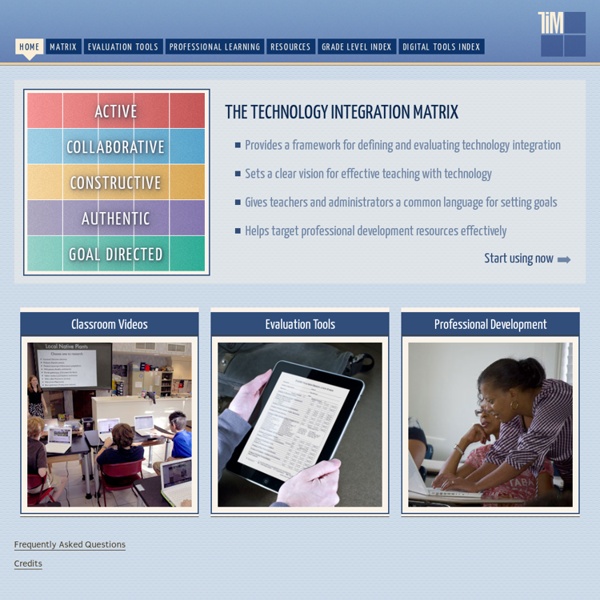



8 Examples of Transforming Lessons Through the SAMR Cycle The SAMR Model for integrating technology into teaching, developed by Dr. Ruben Puentedura, has gained a good deal of exposure in recent years. “SAMR” is an acronym that stands for Substitution, Augmentation, Modification, and Redefinition. The SAMR model provides a technique for moving through degrees of technology adoption to find more meaningful uses of technology in teaching and move away from simply using “tech for tech’s sake”. We recently discussed the SAMR model during an Academic Technology Work Group meeting at The College of Westchester.
How Tech Will Transform the Traditional Classroom Ben Jackson is a writer and app developer living in Brooklyn, NY. He likes clean typography, dirty language, strong coffee, apple pie and comfortable chairs, and he writes about his obsessions at 90WPM. As the post-PC era moves from interesting theory to cold, hard reality, one of the most pressing questions is: How can we use tablets, and especially the iPad, to help people learn? Most of the focus has been on ebooks replacing textbooks, a trend fueled by Apple’s recent updates to iBooks.
6 Common Misconceptions About Blended Learning Infographic Blended Learning Infograpics 6 Common Misconceptions About Blended Learning Infographic 6 Common Misconceptions About Blended Learning Infographic When implementing blended learning, stakeholders may have preconceived notions about this model of learning. The following outlines some common blended learning myths. e-Learning Roadmap The e-Learning Roadmap is a planning tool designed to help your school identify where it currently is in relation to e-Learning, and where it would like to go. The e-Learning Roadmap provides a number of statements under the following headings: Leadership & PlanningICT & the CurriculumProfessional Developmente-Learning CultureICT Infrastructure The statements are categorised as follows: Initial; e-Enabled; e-Confident & e-Mature. The e-Learning Roadmap is available in a number of different formats: Printed as an A2 poster in the e-Learning Handbook.To download as an A2 poster.
9 Ways To Use Social Networks In eLearning - eLearning Industry The eLearning is a term mostly serving to describe deliberate education with advanced technical user-friendly and intuitive teaching methods. Few of us, however, acknowledge the role different social networks play in teaching us to organize the conventional learning process thus merging it with eLearning step by step. Here you can get a rundown of using social networks in eLearning and how they make it ever more readily accessible and integrated for students. Getting to know how to operate these useful branchy GUIs on their own can make you a power user. Flipped Classroom: Beyond the Videos Last week, I read an interesting blog post by Shelley Blake-Plock titled “The Problem with TED ed.” It got me thinking about the flipped classroom model and how it is being defined. As a blended learning enthusiast, I have played with the flipped classroom model, seen presentations by inspiring educators who flip their classrooms, and even have a chapter dedicated to this topic in my book. However, I am disheartened to hear so many people describe the flipped classroom as a model where teachers must record videos or podcasts for students to view at home. There are many teachers who do not want to record videos either because they don’t have the necessary skills or equipment, their classes don’t include a lot of lecture that can be captured in recordings, or they are camera shy.
Getting Started With Knowledge Management - eLearning Industry In the last couple of years I’ve dealt with a few companies that were either unable or unwilling to preserve the knowledge and expertise of their employees. In fact, I was employed at one such organization for quite some time. The company lost money and opportunities, and its image suffered as well, all due to the lack of a comprehensive knowledge management solution. In regards to training, the company put faith in the old “knowledge sharing is king” motto. Technology and Young Children Key Messages When used intentionally and appropriately, technology and interactive media are effective tools to support learning and development. Intentional use requires early childhood teachers and administrators to have information and resources regarding the nature of these tools and the implications of their use with children. Limitations on the use of technology and media are important.
10 Mobile Apps Instructional Designers Should Be Familiar With - eLearning Industry Many Instructional Designers already use mobile devices in their eLearning strategy. They give online learners the power to access valuable online resources and improve their skills from anywhere in the world. However, we can also use mobile apps to our advantage. In fact, here are 10 apps that can help you collaborate on-the-go and manage your time more effectively. 1. What are e-Portfolios? An e-portfolio is a purposeful aggregation of digital items – ideas, evidence, reflections, feedback etc, which ‘presents’ a selected audience with evidence of a person’s learning and/or ability.Sutherland and Powell (2007) If portfolios are ‘simply a collection of documents relating to a learner’s progress, development and achievements’ (Beetham 2005) then e-portfolios could be defined as simply digital collections of these documents. However, ideas of what an e-portfolio ‘is’ are complex and to an extent the definition and purpose will vary depending on the perspective from which a particular person is approaching the concept. Consensus is beginning to grow as experience of e-portfolios develops which will help converge these different ideas and definitions. Essentially then, an e-portfolio is a product created by learners, a collection of digital artefacts articulating learning (both formal and informal), experiences and achievements.
How to Build a Student Portfolio Infographic Educational Technology Infographics How to Build a Student Portfolio Infographic How to Build a Student Portfolio Infographic